DEALING WITH STRESS
You probably have some days when you feel overwhelmed, worried, anxious, and stressed. Maybe you have a test and a paper due on that same day. Maybe you're arguing with your friend or your parents.
ACTIVITY 6: Saying “No”
ACTIVITY 6: Saying “No”
Examine the two illustrations. Then, think about the differences. Click on each image to view an enlarged version.
Illustration 1
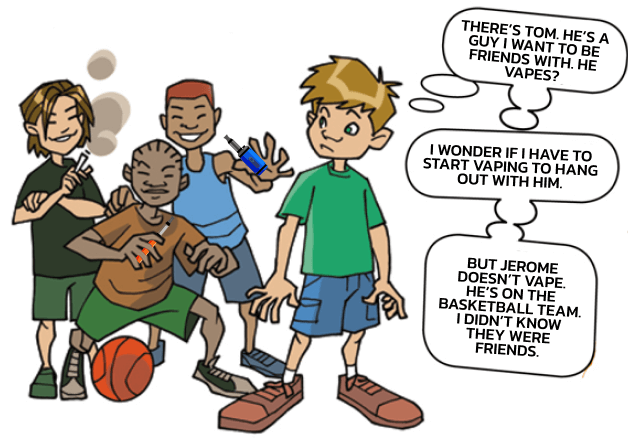
Illustration 2
Which illustration is an example of peer pressure?
Which is an example of peer influence?
ACTIVITY 6: Saying “No”
ACTIVITY 6: Saying “No”
Look at the questions in the bubbles. Then, type in your responses. Afterwards, continue to Page 5.
Do you think Tom, the vaper, will like the boy in the picture if he vapes? Why or why not?
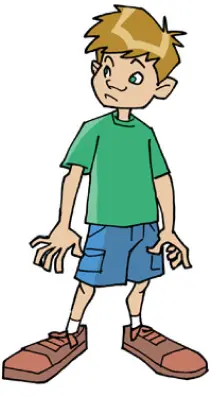
What advice would you give the boy about not vaping and about saying "no" to peer influence?
ACTIVITY 6: Saying “No”
ACTIVITY 6: Saying “No”
Read what the boy is thinking, then go to Page 4.
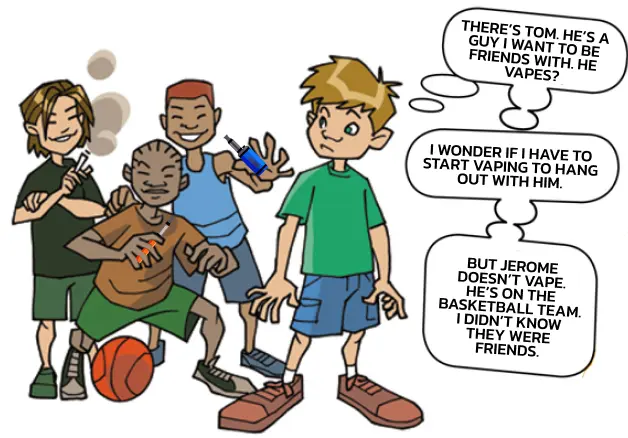
ACTIVITY 6: Saying “No”
ACTIVITY 6: Saying “No”
Look at what Jody's friends are saying to her, then go to Page 2.
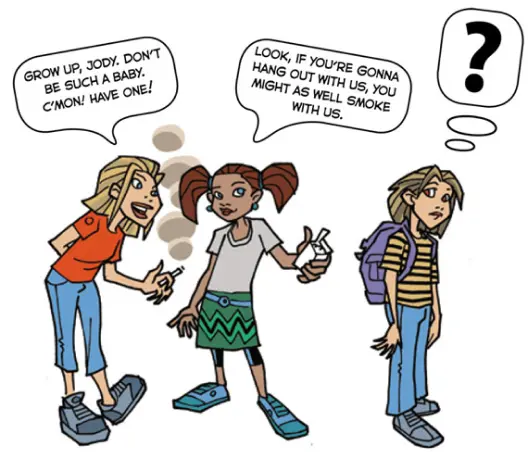
ACTIVITY 6: Saying “No”
ACTIVITY 6: Saying “No”
Look at the questions in the bubbles. Then, type in your responses. Afterwards, continue to Page 3.
What do you think Jody should do? Why?
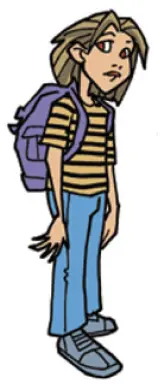
How can she tell her friends that she does not want to smoke?
Do you think her friends will really tell her that she can't hang out with them if she does not smoke?
If they do tell her that they don't want her around, what does that say about their friendship?
ACTIVITY 6: Dealing with Stress
ACTIVITY 6: Dealing with Stress
You probably have some days when you feel overwhelmed, worried, anxious, and stressed. Maybe you have a test and a paper due on that same day. Maybe you're arguing with your friend or your parents.
ACTIVITY 6: Thinking Your Way to Good Decisions
ACTIVITY 6: Thinking Your Way to Good Decisions
Imagine yourself in the two hypothetical situations you’ll see on the next screens. Read each one and then discuss the questions that follow with your group. Talk about what you think might be the consequences for the friendships, and how you might deal with the consequences if this were to happen to you.
ACTIVITY 6: Saying “No”
ACTIVITY 6: Saying “No”
You've been reading about how friends can influence our decisions and the way we think. Sometimes this can be a good thing, but sometimes it causes us to make the wrong choices.
In this section, students explore their relationships with others. The activities focus on peer relationships and how peer pressure, influence, and acceptance affect their lives. There are also activities on refusal skills to help equip students with strategies for saying "no".
This activity is designed to help students use their knowledge of peer pressure and influence (or the desire for acceptance) to reassess their thoughts and preconceptions about what happens in peer groups. You may wish to have students complete the activity in small groups; alternately, consider presenting the activity on an interactive whiteboard and completing it as a class.
If students will be completing the activity in small groups, organize them into groups and share the digital activity link below with each group. Alternately, present the activity to the class as a whole.
Ask students to read the first scenario and talk among themselves about what they think might happen. They should use the questions listed in the activity as a framework for discussion.
Discuss each scenario separately. In the first one, get the students to talk about why they might get tired of their friend asking to copy homework. Ask if there is a part of them that does want to give him the homework, and if so, why? Ask students:
Wrap up the discussion by talking about how relationships are bound to have conflicts and disappointments, and that these might generate some anger or hurt feelings, but in most cases these feelings subside. Talk about how we can value our relationships enough to accept the good with the bad.
In the second scenario, have the students examine whether or not they would feel as though they would be treated differently by their friends.
To conclude, ask students to complete the “You Decide!” portion of the activity. Then, zero in on the decision not to smoke. Explain that in some cases, people continue to smoke even if they initially don’t like it. Reinforce the wisdom of the decision not to smoke, and how it reflects priorities. (For example, “It’s more important not to do something I don’t like than it is to be accepted in my peer group.”)
In this section, students explore their relationships with others. The activities focus on peer relationships and how peer pressure, influence, and acceptance affect their lives. There are also activities on refusal skills to help equip students with strategies for saying "no".
In this activity, students will examine two illustrations demonstrating peer pressure and peer influence to use tobacco or nicotine. They will answer questions about what a character might be thinking and ultimately will do in each situation.
Share the digital activity link below with your students. They can complete this activity independently or in groups.
Once everyone has finished, meet as a class to discuss the pictures and students’ answers. Point out the good feelings that might be had by the student who refused the temptation/pressure to participate and just walked away instead. Reinforce the feeling of inner strength and self-control this student would have for refusing. Ask students to think about how they would handle themselves in each case.
Ask students to share the advice they would give to the boy about not smoking or vaping. Write these answers on chart paper so that you can keep it on display as a reminder to your students about why they should stay tobacco and nicotine free.
In addition to trying to determine what characters might think and do, students will be asked to determine which illustration is an example of peer pressure (#1) and which peer influence (#2). Encourage students to talk about the differences between the two illustrations so they are able to ascertain that some pressures are self-generated. They would also do well to explore why they feel these pressures.